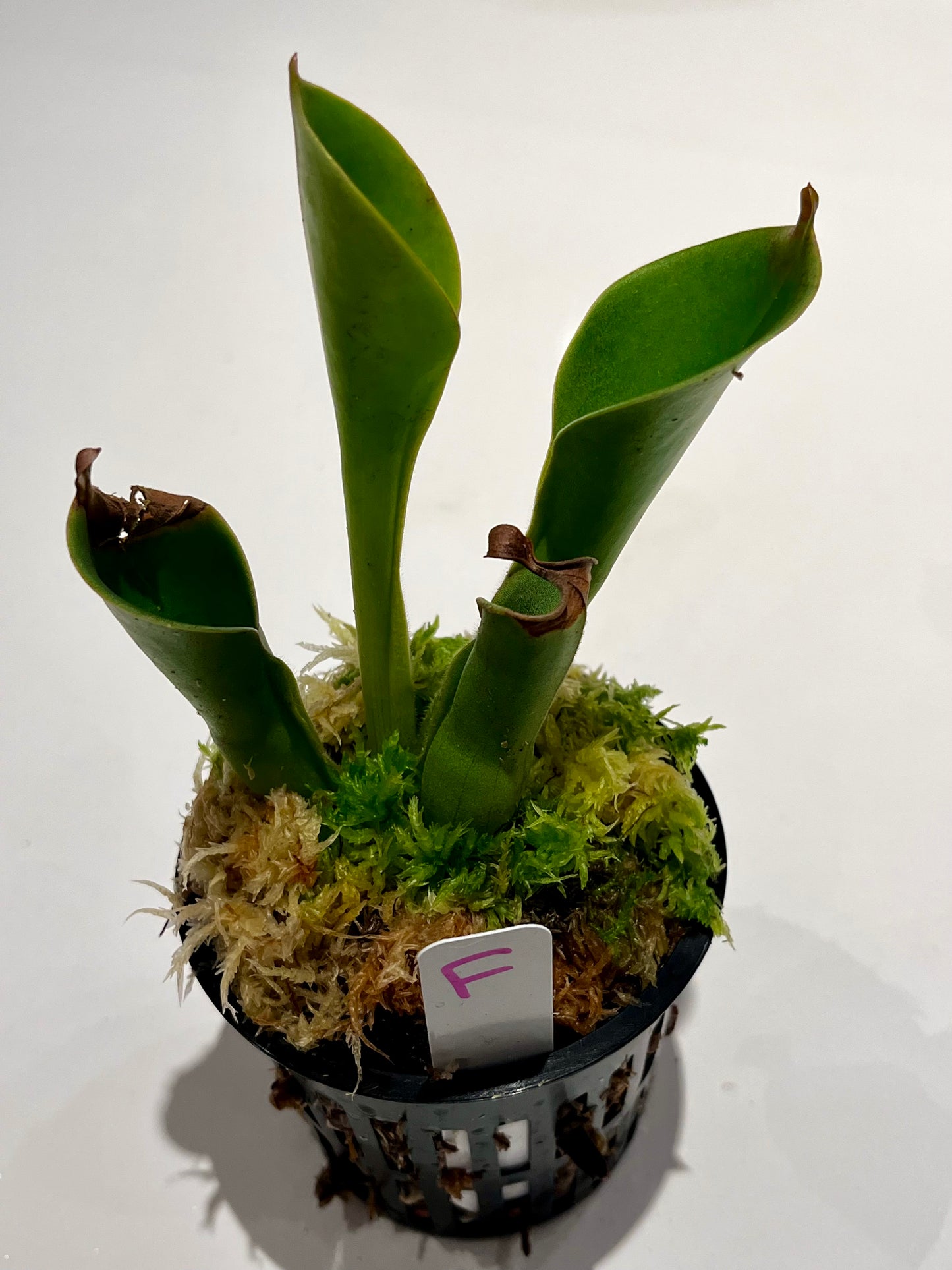The Trappery LLC
Heliamphora heterodoxa x nutans 'Wild Bill' clone
Heliamphora heterodoxa x nutans 'Wild Bill' clone
Large and vigorous Heliamphora hybrid. This Sun Pitcher forms big green pitchers with a prominent nectar spoon when grown in high light. These divisions are being offered in 3 inch net pots with live sphagnum moss.
Exact plant shown for each option. A new leaf or two might grow depending on how long the listing lasts for. Older pitchers slowly brown from the top down but still actively absorb nutrients untill they fully dry out.
Couldn't load pickup availability






Collapsible content
A Sun Pitcher Plant Grow Guide
Heliamphora, also known as sun pitchers, are a captivating genus of carnivorous plants native to the mist-shrouded tepuis (tabletop mountains) of South America. With their graceful upright pitchers, nectar-luring spoons, and cool-climate adaptations, they are a rewarding challenge for growers looking to expand into highland species.
While not as forgiving as beginner plants like Drosera or Nepenthes hybrids, many Heliamphora species can thrive with the right balance of light, temperature, humidity, and water quality. This guide walks you through their needs so you can confidently grow and enjoy these high-elevation marvels.
Key Care Requirements
Light: The Engine of Growth
In their native habitat, Heliamphora grow in bright, diffused light with cloud cover rolling in and out throughout the day. Strong light is essential for pitcher coloration, growth speed, and flowering potential.
- Natural Light: Place in a very bright windowsill, greenhouse, or sunroom. If outdoors, provide filtered sun or partial shade. Morning sun and afternoon cover work best.
- Artificial Light: Use full-spectrum LED grow lights, positioned 6–12 inches above the plant for 12–14 hours a day.
Check out our cultivation guide about Light
Insufficient light results in floppy leaves and poor coloration. Proper lighting brings out reds, purples, and deep pitcher tone.
Water: Purity is Essential
Like other carnivorous plants, Heliamphora are extremely sensitive to minerals and require very clean water. Their roots are adapted to nutrient-poor, constantly wet soils.
- Golden Rule: Only use distilled water, reverse osmosis (RO) water, or rainwater with low TDS (<50 ppm).
- Method: Top-water generously to flush the soil. Keep the soil consistently moist, but not soggy, and avoid standing water. A shallow humidity tray can help regulate ambient conditions.
Check out our cultivation guide about Water
Never let Heliamphora dry out, but avoid waterlogging the pot for long periods.
Soil: Drainage and Airflow First
Heliamphora prefer a cool, moist, and well-draining soil mix. The right blend allows constant moisture while preventing root rot in cooler environments.
- Recommended Mix: 2 parts long-fiber sphagnum moss, 1 part perlite or pumice, 1 part orchid bark or fine tree fern fiber (optional for structure)
- Never Use: Regular potting soil, compost, or fertilizers in the mix.
- Check out our cultivation guide about Soil
Use tall pots with excellent drainage to mimic their native root run in rocky, rain-soaked slopes.
Temperature & Humidity: Cool, Consistent, Cloud-Forest Conditions
Heliamphora are highland plants and require cool nights, mild days, and high humidity to thrive. They do not tolerate tropical lowland heat well.
- Temperature: Day: 65–78°F (18–26°C), Night: 45–60°F (7–15°C) A night drop is essential for long-term health
- Humidity: Keep 70–90% RH, especially in dry indoor environments
- Use ultrasonic humidifiers, foggers, or grow tents with sealed airflow
Check out our cultivation guide about Temperature
Check out our cultivation guide about Humidity
High humidity is important, but stagnant air can cause rot. Use gentle airflow to maintain balance.
Feeding: Optional, but Beneficial
Heliamphora catch prey passively, relying on rainfall and insects slipping into their upright pitchers. While they don’t require feeding to survive, occasional nutrients can boost growth and pitcher production.
- Method: Add a small insect (like a gnat or tiny cricket) into a mature pitcher every 2–4 weeks. Pitchers must have water in them (or pitcher fluid) to digest effectively
- Fertilizer (Optional): Foliar feed with 1/4 strength MaxSea 16-16-16 or similar urea-free fertilizer once a month
- You may also apply a few drops into active pitchers, but avoid fertilizing the soil
Check out our cultivation guide about Nutrients
Overfeeding or fertilizing the wrong way can cause pitcher burn or rot, less is more.
Final Tips from The Trappery
- Always allow for nighttime cooling, even indoors
- Use tall pots with excellent drainage and aeration
- Mist regularly, but don’t drench unless light and airflow are ideal

